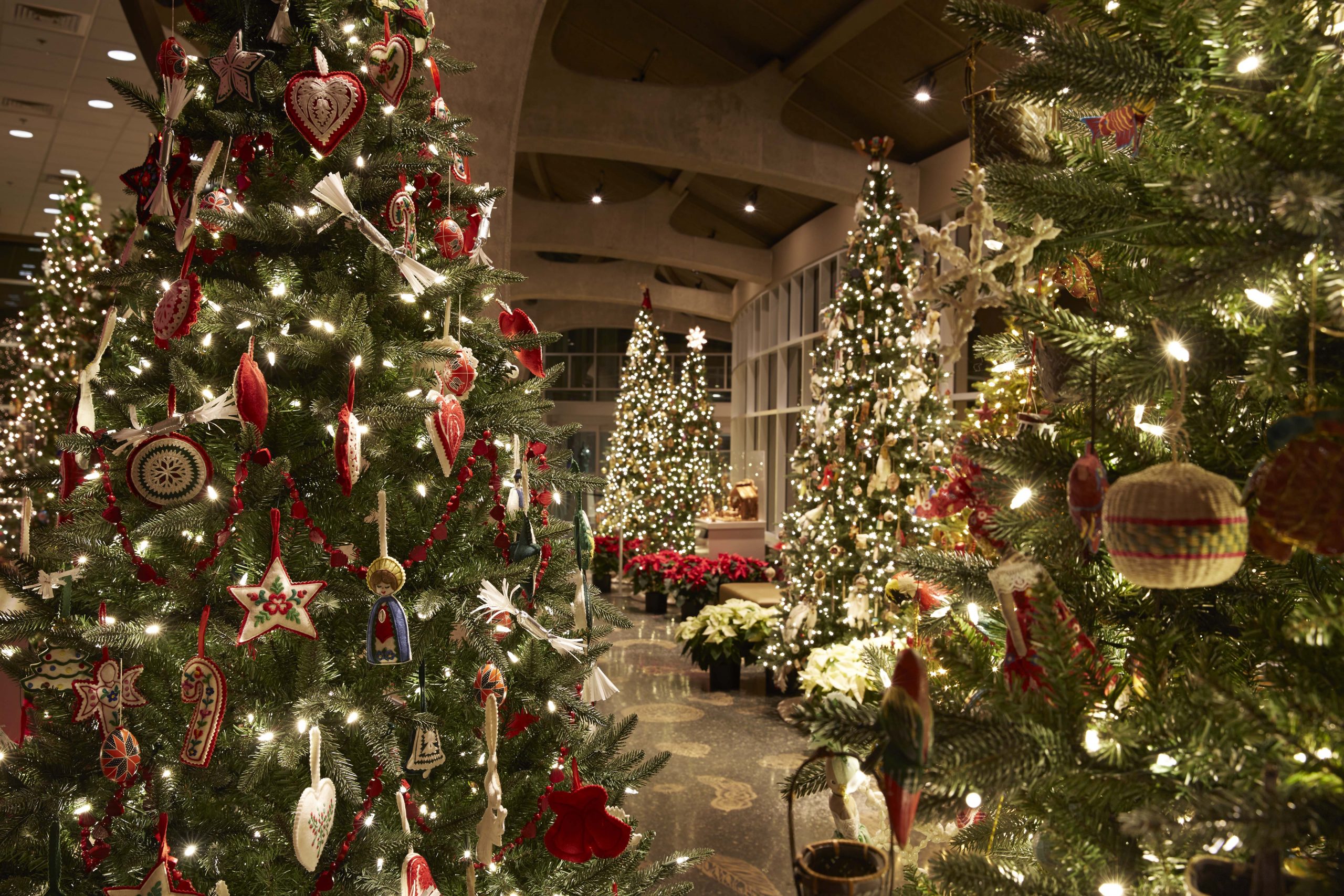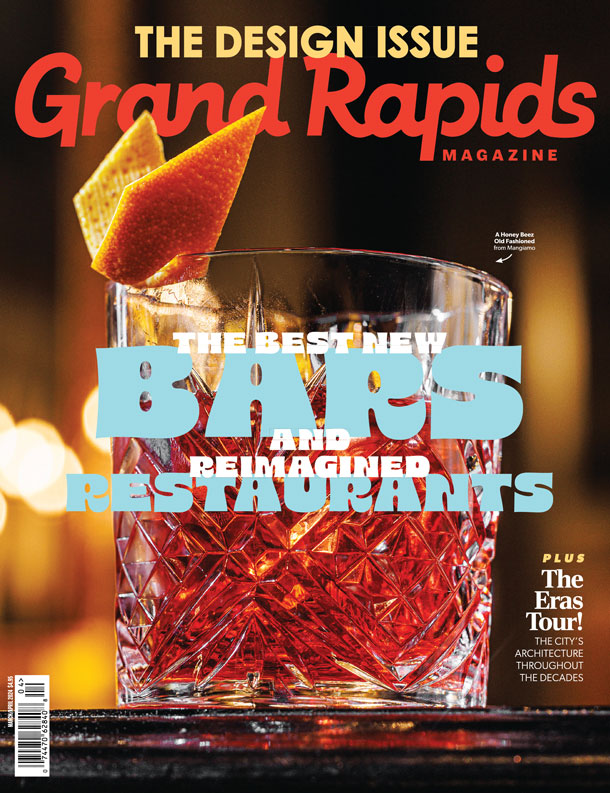The holiday season is important to almost everyone in West Michigan, but not everyone celebrates in the same way. The term “holidays” means different things to different people, but for the most part it’s a chance to enjoy the company of family and friends while honoring traditions and making lifelong memories.
Christmas (trees) around the world
Roberta Craig has been volunteering at Frederik Meijer Gardens and Sculpture Park for 17 years and has helped with Christmas celebrations for most of them.
In fact, she remembers when the menagerie of Christmas trees — a holiday staple at the Gardens — were still real, actual trees. They’d get dry and brittle, and they’d have to be swapped out during off-hours to sustain the hot, bright lights.
“I don’t know if it was a fire code, but they wanted them taken down and put back up with a fresher, live tree,” Craig said, recalling a flurry of prep work to make sure they were changed on time for the next round of guests. “So that was always quite a hustle.”
This holiday season, the trees — now artificial — are back for yet another year at the Gardens. The University of Michigan Health-West Christmas & Holiday Traditions returns, with dozens of themed Christmas trees from around the world and more — set to run from Nov. 23 to Jan. 2 at the Gardens’ campus on East Beltline Avenue.
“We have a beloved railway garden, and we have a spectacular outdoor light display,” said Lisa Roo, lead designer and project manager with the Gardens. “And then we have the Christmas trees and cultural displays — 27 Christmas trees and 15 cultural displays.”
As usual, they run an impressive gamut. Roo passes along a list of expected trees at this year’s event, including an American Indian tree, a Canadian tree, trees decorated in the style and culture of Lithuania, Ireland, Spain, the Middle East and Belize. Cultural displays, likewise, are set for Kwanzaa, Eid ul-Fitr and more.
Set for the spotlight, Roo said, is the tree from Austria.
“A lot of famous composers came from Austria, and so we have objects that represent music,” Roo said, like music books and violins and an ornament honoring the Austrian chapel where Silent Night was first sung. “And a lot of gold and gilding to be reminiscent of some of the architecture there.”
Another beloved tree is German-themed, in honor of Lena Meijer, a matriarch in the Gardens’ namesake family. Roo recalls it has a small pickle ornament, according to German tradition — in which the first child to find it either receives a special gift or opens the first Christmas present.
Marge LaBreck is another longtime volunteer with the Gardens. Among her favorites is the Ukraine tree, which in past years has referenced an Eastern European folk tale of an old widow and her children. In the hours before Christmas morning, the story goes, a spider draped the tree in webbing that turned to silver at first light — lifting the family out of poverty on Christmas morning.
LaBreck said she particularly likes the cobweb decorations that have often marked the tree at the Gardens. But, she said, she also likes plenty of other parts of the celebration that range far beyond Christianity — to Hanukkah, Kwanzaa and more.
“If we understand other cultures, how they celebrate, then we have a better way of communicating with them,” she said. “I think it’s important for us to learn more about other cultures, and then we can be more understanding.”
Special events and performances are scheduled at the Gardens on Tuesdays leading up to Christmas, like Dickens-era carolers and visits from Santa Claus. Samuel Nalagria will perform Ugandan music on those evenings as well. More information on the displays and event schedule are available on the Gardens’ website, meijergardens.org.
And, as always, LaBreck said, one of the best parts of helping make the event happen is seeing what it means to its youngest guests.
“It’s magical,” LaBreck said of the Gardens’ celebrations. “That’s the only way I can describe it.
“To watch the children’s faces, when they come in and they feel the lights and all the trees.”
Mel Trotter’s feast for all
If you’d like to know how Mel Trotter Ministries pulls off its annual Thanksgiving dinner — filling up a huge space at DeVos Place in downtown Grand Rapids — you could do a lot worse than the classic iceberg metaphor. There are months of preparation beforehand that guests never see, including an all-consuming push that marshals hundreds of volunteers to set hundreds of tables for hungry guests.
Dawn Kaltenberg-VanHorn, a volunteer coordinator with Mel Trotter, knows all about it. She’s worn different hats over the years but has helped make the meal a success since 2019.
“The event itself is really two hours — not even a full day,” she said of this coming year. “But it’s months of planning … as it gets closer and closer, we’re meeting every two weeks, every week. The event coordinator and I are kind of behind the scenes, working endless hours on it from about August on.”
This year’s Thanksgiving Dinner is set for 11 a.m.-1 p.m., Nov. 25, served to members of the community free of charge. The event is designed not just for the needy, but to help build a local sense of community, too; no registration is needed, and guests can simply show up at DeVos Place.
“It’s amazing. It takes up almost the whole DeVos Place,” Kaltenberg-VanHorn said, describing about 144 tables that cover the main concourse plus nearby space as well, ready for a parade of volunteers.
“If you’re ever in a room with 600, 700 (people), with everybody wearing the same outfit — it was just a sea of blue of everybody in these volunteer shirts. It was a really fun experience,” Kaltenberg-VanHorn said, recalling earlier years.
“And then to see the guests, the community people, coming in, and volunteers serving and interacting (with them) — it’s a really neat time to be a part of.”
Mel Trotter also is hosting its annual Turkey Drop on the Wednesday before Thanksgiving — that’s Nov. 17 — where people can come to Celebration Cinema’s north and south locations and donate frozen turkeys to help feed the community.
The annual DeVos Place dinner fills an important need in Kent County — one that COVID-19 has only deepened. The most recent federal statistics put the childhood poverty rate at nearly 15% pre-pandemic. Since then, the virus has brought nearly 18 months of economic tumult. Job loss has been followed by stimulus and boosted unemployment, but as Mel Trotter Chief Advancement Officer Beth Fisher points out, the end of a federal eviction moratorium will pose an extraordinary challenge for a number of local renters.
Last year, the dinner had to adapt to the COVID-19 pandemic. Coronavirus infections spiked to all-time highs during last year’s holiday season, forcing the event to stay at the Mel Trotter mission’s downtown location along Commerce Avenue; directly serving food to a much smaller group while working with Kids’ Food Basket to get donated food to pantries throughout the area.
And concerns about COVID-19 still, of course, persist. Michigan’s coronavirus numbers had tapered with the rest of the country’s this spring but have surged in recent months. In the early fall, those figures were still far below last year’s spike — but a spike in infections could still force changes in the event.
“Our expectations, I would say, are laced with an underlying sense of hope,” Fisher said. “We hope that we absolutely will be back in person this year, as we greatly missed it last year.
“What we expect, I think it’s what everybody else does in West Michigan. We expect that we should probably plan for a contingency plan, hoping that we won’t need to use it.”
The day is an opportunity not just to meet a material need, Fisher said. It’s also a chance to connect with people who might not always have the opportunity — especially amid the isolation of a pandemic. So even though COVID-19 looms, she’s hopeful the event can go off at DeVos Place as planned this year.
“It would provide an incredible sense of continued hope,” Fisher said. “I think it would restore hope, and so many of us who have potentially struggled to have it throughout last year, and I think it would provide us with a sense of normalcy, and …a chance to reconnect in ways we were unable to last year.
“And ultimately, that’s why we exist. We exist to demonstrate the compassion of Jesus every single day. We know that Jesus spent time in community with people. That’s what we’ve all been longing to do, and hopefully we’re able to do it.”
Hanukah on the Calder
The menorah is big. Extremely big. It’s in two pieces but put together it’s easily four times as tall as Rabbi Yosef Weingarten, who’s sporting a white beard and a yarmulke in the lot behind Chabad House of West Michigan, where the menorah is stored behind the parking lot.
The synagogue — and the decades-old gigantic menorah — are tucked along Michigan Street in northwest Grand Rapids. But come November, Chabad House will haul it out to Calder Square, where they’ll mark eight days of Hanukkah in the city’s most public space, reminding the community what it means to celebrate the Jewish holiday.
In case you don’t recall: Hanukkah marks the “miracle of the oil,” after Hebrews successfully revolted and reclaimed the Temple in Jerusalem in the 100s B.C. One day of oil to light lamps miraculously lasted for eight — hence the days-long celebration observed today.
“Everybody should learn that God can perform miracles then and even now,” Weingarten said. “That’s why we light it on public property.”
It’s a years-old tradition. Sitting with his daughter Rivka, Chabad’s program director, the two remember that their menorah dates to the 1980s. Rivka has pictures of its early days, and she laughs together with her father when they point to him, sporting a much darker beard, in fading pictures — the menorah tilted on its side in what looks to be a sepia-toned machine shop.
This year, the menorah is scheduled for a “grand lighting” at 5 p.m. Nov. 28. They’re hoping it’s just as memorable as years past.
For the last six or seven years, Rivka recalls, Chabad House has held an annual Hanukkah event at Calder Square — with music and entertainment and more — alongside observances and lamp-lightings lasting the duration of the holiday.
The mayor has offered remarks; firefighters have climbed to the top of their tall ladders and tossed gelt (chocolate coins) and small toys to kids. Yes, Rivka confirms: This public display is a huge hit with the children.
The pandemic has made for strange times at Chabad House, though. The rabbi, standing in the back lot, points over to parking spaces where he said the very first COVID-era service at Chabad was held in a parking lot full of cars. The Torah, he remembers, was brought out to meet them. As Weingarten says: It’s important to adapt.
The same is true of Chabad House’s Hanukkah service. In 2020, the synagogue had all its attendees line up in a row of cars decorated for Hanukkah. One of them, Rivka laughs as she remembers, had a huge inflatable dreidel on top.
With a police escort, they all paraded down to Ottawa Avenue —across from the Calder and City Hall — and tuned their radios in to a tiny local broadcast. Such is adaptation in the age of COVID-19.
Rivka was speaking months before the holiday season, but she said it was already time to get ready. There’s plenty to get done ahead of a big event — coordinating the donuts and the latkes (oil-fried treats, in observance of the holiday) and booking musical acts and all the other details that make an event a success. During COVID-19, Rivka said, it’s hard to know who will be available.
It’s a special joy to see the event succeed amid the pandemic, though. Last year’s event, which brought out maybe 150 people, stands out.
“It was amazing. It was amazing to see people. It was amazing to get out, to celebrate the holiday and celebrate Jewish pride,” Rivka said. “Because that’s what I consider that event downtown as — Jewish pride. And I think it’s amazing to see how many people come out to that. Last year especially, but in past years, too.
“And to see non-Jewish people out there to support us and showing that they care and that they’re proud to be friends of Jews. That means a lot.”
Kwanzaa celebrates community
The “one-stop culture shop,” as Jewellynne Richardson calls it, is nestled along Eastern Avenue in southeast Grand Rapids, stuck to the side of a hair place.
It’s full of the passion she has for Black and African culture — a stack of drums, earrings splashed with green, yellow and red, and a small poster of broken shackles.
“No child under 13 shall be handcuffed,” it reads, “unless under extreme circumstances.”
She’s sitting down to explain it all after tending to clients next door.
“What I’ve learned is, for Blacks, the only two safe spaces that have been traditional over the years have been churches and hair shops,” she said. “That’s where we can go and we can be who we are.”
Richardson is the artistic director and a founding member of West Michigan Jewels of Africa, one of multiple groups helping bring Kwanzaa to life in Grand Rapids this year. To hear Richardson tell it, it’s a week of celebrating Black identity and building Black community.
“Juneteenth is (not just) a holiday, but is a way we live,” she said, referring to the annual celebration of the end of slavery in the U.S. “Kwanzaa is a holiday, but it’s not a religious holiday.
“It’s a celebration, it’s a festival.”
Richardson said this year, a concert kicks off the week of Kwanzaa on Dec. 26 at St. Mary’s Temple of Peace Spiritual Church, at 1106 Sheldon Ave. SE. The night starts at 5 p.m. with an artists market, followed by a soul food dinner, and capped with a concert at 7 p.m. Donations are encouraged at the concert.
Throughout Kwanzaa, Richardson said, there will be a continuing celebration of Black businesses along the Eastern Avenue corridor, with a regular fellowship at 6 p.m. nightly outside the culture shop at 1541 Eastern Ave. SE., with a Kwanzaa candle-lighting ceremony.
This year, after the tumult of 2020, there’s a special historical resonance to Kwanzaa. The holiday was created in 1966 by Maulana Karenga, a Black Studies professor at California State University, in the wake of the Watts Riots — a Black uprising that began with a police traffic stop that consumed Los Angeles for days.
Kwanzaa, created to help unite the African American community, revolves around seven key principles and seven symbols celebrated across seven nights — like unity, self-determination and creativity, or an ear of corn, crops and seven candles. Richardson calls it an affirming event for Black Americans — an act of reclaiming common culture.
That’s just as much true after last year’s difficult season of uprisings after the murder of George Floyd. Within a week of Floyd’s death, for example, downtown Grand Rapids was convulsed by rioting (the aftermath has seen Grand Rapids police promise reforms meant to make the department more community-oriented).
“The importance of this concert is to let (people) know that we are forever surviving and evolving,” Richardson said. “Kwanzaa lives beyond us. That’s what it’s about. It’s about living beyond the tragedy of George Floyd. Standing up proud and saying ‘We know these tragic things happen … and we have always been overcomers. And we will overcome this.”
“Baba” Kevin Collins is CEO of the African Drum and Dance Parent Association, a Flint-based group.
WMJOA is a subsidiary, he said; the association, of which Richardson is also a leader, is helping make Grand Rapids Kwanzaa celebrations happen.
“it has really grown (over) many years,” he said. “We know a lot of people didn’t used to celebrate Kwanzaa, but it’s growing. You’ve got a lot of churches and organizations finding out that this brings people together.”
This story can be found in the November/December 2021 issue of Grand Rapids Magazine. To get more stories like this delivered to your mailbox, subscribe here.











Facebook Comments